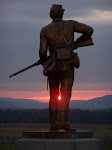
Greetings all. I have been very busy with research and some new programs. Most recently, I've started leading Pickett's Charge tours as part of my internship duties. It's been a great time. The park offers some twenty free programs every day through August 16, so make use of them while summer is still here!
Earlier in my internship, we got to attend a series of ranger orientation programs. One included an in-depth tour on Culp's Hill with Ranger Troy Harman. One of our first stops was the statue of Union General George Sears Greene (seen above), who could easily be considered the savior of Culp's Hill during the battle.
Earlier in my internship, we got to attend a series of ranger orientation programs. One included an in-depth tour on Culp's Hill with Ranger Troy Harman. One of our first stops was the statue of Union General George Sears Greene (seen above), who could easily be considered the savior of Culp's Hill during the battle.

George Greene was born May 6, 1801 in Apponaug, Rhode Island and would live for another ninety-seven years. (Yes, he came close to living in three different centuries!) Greene eventually became a brilliant engineer, graduating as such from West Point. He went on to instruct at the Point and even taught Robert E. Lee for a time. Greene would go on to design the water systems for New York City as well as other major cities.
At the Battle of Gettysburg, next to Gen. William "Extra Billy" Smith, Greene was the oldest officer on the field at 62. His quick thinking and skill in engineering all but saved the Federal positions on the hill.
At the Battle of Gettysburg, next to Gen. William "Extra Billy" Smith, Greene was the oldest officer on the field at 62. His quick thinking and skill in engineering all but saved the Federal positions on the hill.
In our video, Troy Harman tells us a bit about the colorful life of General Greene, and how the position of Union troops on Culp's Hill came to be. We are standing right underneath the Greene Statue at the summit of the hill.

A map of the Confederate assault on Culp's Hill late on July 2, 1863.

This photo was taken from Rhode Island's Own, a series in early Civil War biographies. Greene probably wore something similar to this while in battle. Doesn't he look more "field ready" in this photo? After Gettysburg, Greene and many of his men were sent westward, fighting in battles such as Chattanooga. At the Battle of Wauhatchie in late October 1863, Greene was shot in the face. Greene was with William T. Sherman's army during the Confederate surrender in North Carolina in 1865.

This shows the base of the Greene Monument. After the war, Greene continued to serve as an engineer for various agencies. At ninety, Greene walked sixty miles of canal lines and water systems he had designed decades earlier to make sure all was still functioning correctly. In 1892, he applied for a government pension, but was only offered that of a lieutenant's rank. So, at age ninety-three, Greene re-enlisted as a first lieutenant and remained as such for two full days. Perhaps he was the oldest lieutenant ever?

The general had some hard fighting sons as well. Greene's son, Samuel Dana, commanded the famed ship Monitor when it fought Virginia in 1862. The youngest son served at George's side at Gettysburg.
Greene died on January 29, 1899 in New Jersey, but was buried back home in Rhode Island. The large boulder shown above his grave was taken from the slopes of Culp's Hill. One of Greene's officers wrote of his commander, "He knew how to drill, how to command, and in the hour of peril how to care for his command..."
Greene died on January 29, 1899 in New Jersey, but was buried back home in Rhode Island. The large boulder shown above his grave was taken from the slopes of Culp's Hill. One of Greene's officers wrote of his commander, "He knew how to drill, how to command, and in the hour of peril how to care for his command..."









No comments:
Post a Comment